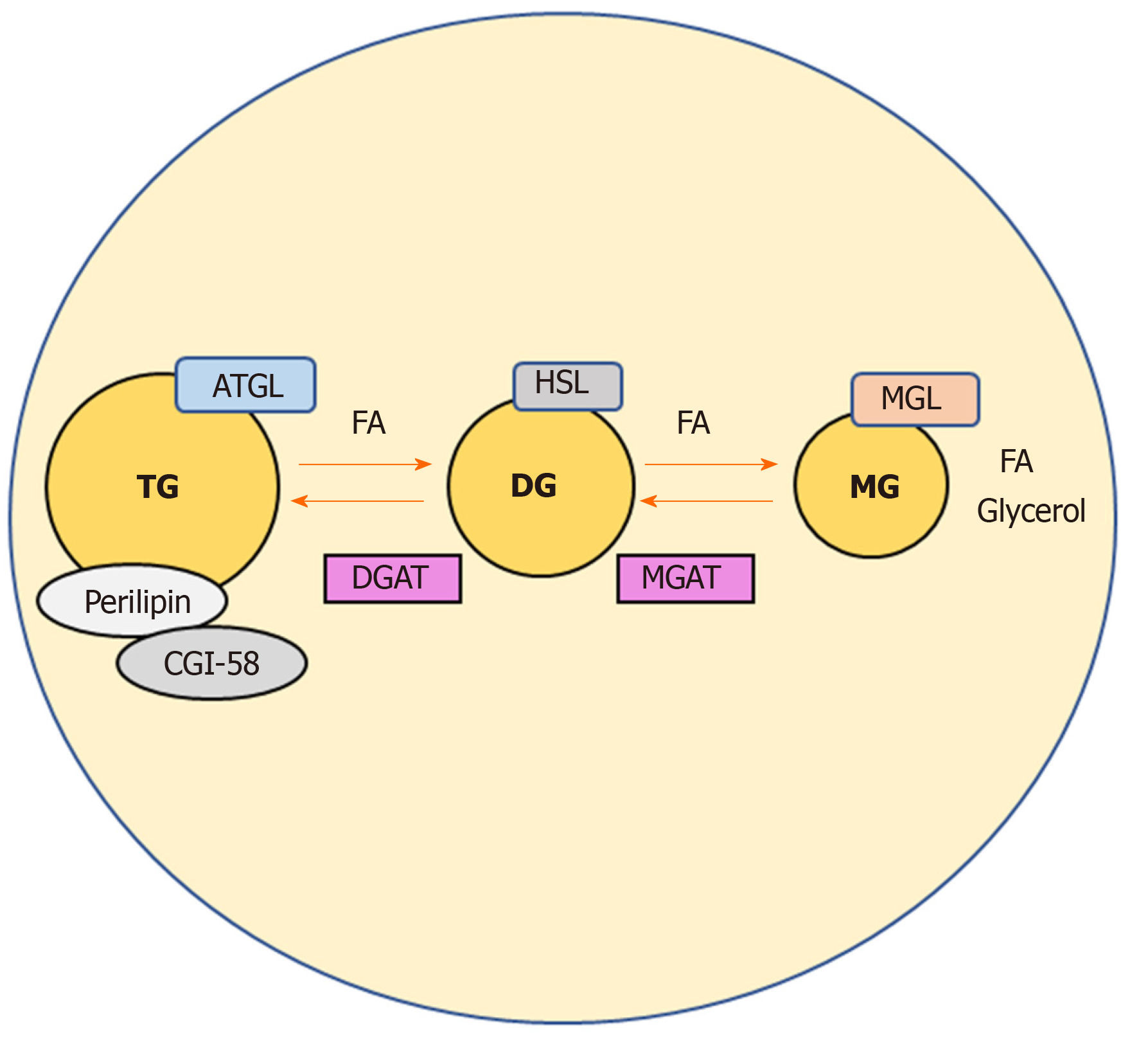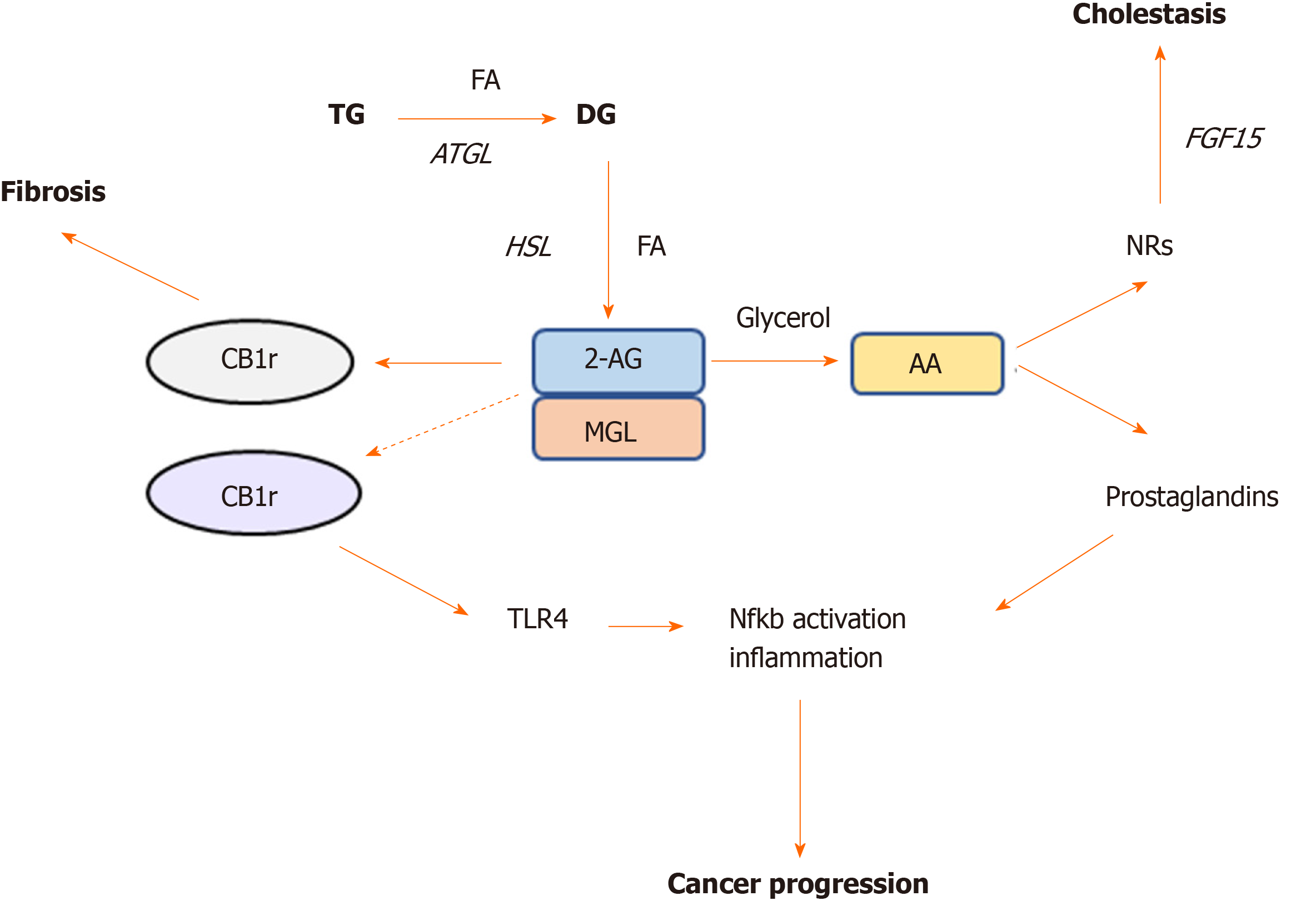Copyright
©The Author(s) 2020.
World J Gastroenterol. Jul 7, 2020; 26(25): 3577-3585
Published online Jul 7, 2020. doi: 10.3748/wjg.v26.i25.3577
Published online Jul 7, 2020. doi: 10.3748/wjg.v26.i25.3577
Figure 1 Catabolic pathways regulating triglycerides levels in adipocytes.
Adipose triglyceride lipase, hormone sensitive lipase, and monoacylglycerol lipase act on triglycerides in a series of subsequent reactions in order to generate glycerol and fatty acids. Comparative gene identification-58 binds to perilipin facilitating lipolysis, as a known activator of adipose triglyceride lipase. Intermediates of this catabolic pathway may also be re-esterified to phospholipids and triglycerides by the enzymes monoacyglycerol acyltransferases and diacylglycerol acyltransferase. ATGL: Adipose triglyceride lipase; HSL: Hormone sensitive lipase; MGL: Monoacylglycerol lipase; TGs: Triglycerides; FAs: Fatty acids; CGI-58: Comparative gene identification-58; MGAT: Monoacyglycerol acyltransferases; DGAT: Diacylglycerol acyltransferase.
Figure 2 Monoacylglycerol lipase represent a crossroad between cannabinoid and lipid signaling pathways.
Monoacylglycerol lipase is the key enzyme degrading the endogenous cannabinoid ligand 2-AG, which in turn is able to bind either cannabinoid receptor (CB) -1r or -2r. Activation of CB1r was found to promote fibrosis whereas CB2r is involved in TLR4 activation and immune cells recruitment in cancer. Monoacylglycerol lipase action further hydrolyzes 2-AG into arachidonic acid, which is a precursor of prostaglandin synthesis, the main drivers of inflammation. Arachidonic acid was also found to bind nuclear receptors such as farnesoid X receptor and peroxisome proliferator activated receptors in the intestine and ameliorate cholestatic disease. AA: Arachidonic acid; NRs: Nuclear receptors; CB: Cannabinoid; MGL: Monoacylglycerol lipase; HSL: Hormone sensitive lipase; ATGL: Adipose triglyceride lipase; TG: Triglyceride; FA: Fatty acid.
Figure 3 Monoacylglycerol lipase deletion impacts gut-liver axis via nuclear receptor and microbiome modulation.
Monoacylglycerol lipase ablation ameliorates cholestatic liver disease induced by 3,5-diethoxycarbonyl-1,4-dihydrocollidine challenge diminishing fibrosis, inflammation, and fatty acid metabolism/oxidation in the liver. Accumulation of arachidonic acid binds nuclear receptors such as farnesoid X receptor, downregulating in turn fibroblast growth factor 15 and inducing bile acids synthesis and detoxification as shown by Cyp7a1/Cyp3a11. In addition, proinflammatory Proteobacteria were diminished in feces from Mgl-/- mice. AA: Arachidonic acid; NRs: Nuclear receptors; FGF15: Fibroblast growth factor 15; BA: Bile acids.
- Citation: Tardelli M. Monoacylglycerol lipase reprograms lipid precursors signaling in liver disease. World J Gastroenterol 2020; 26(25): 3577-3585
- URL: https://www.wjgnet.com/1007-9327/full/v26/i25/3577.htm
- DOI: https://dx.doi.org/10.3748/wjg.v26.i25.3577











